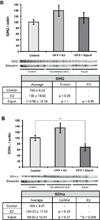Hippocampal responsiveness to 17β-estradiol and equol after long-term ovariectomy: implication for a therapeutic window of opportunity
- PMID: 21241683
- PMCID: PMC3081673
- DOI: 10.1016/j.brainres.2011.01.029
Hippocampal responsiveness to 17β-estradiol and equol after long-term ovariectomy: implication for a therapeutic window of opportunity
Abstract
A 'critical window of opportunity' has been proposed for the efficacy of ovarian hormone intervention in peri- and post-menopausal women. We sought to address this hypothesis using a long-term ovariectomized non-human primate (NHP) model, the cynomolgus macaque (Macaca fascicularis). In these studies, we assessed the ability of 17β-estradiol and equol to regulate markers of hippocampal bioenergetic capacity. Results indicated that 17β-estradiol treatment significantly increased expression of mitochondrial respiratory chain proteins complex-I and -III in the hippocampus when compared to non-hormone-treated animals. Expression of the TCA cycle protein succinate dehydrogenase α was decreased in animals treated with equol compared to those treated with 17β-estradiol. There were no significant effects of either 17β-estradiol or equol treatment on glycolytic protein expression in the hippocampus, nor were there significant effects of treatment on expression levels of antioxidant enzymes. Similarly, 17β-estradiol and equol treatment had no effect on mitochondrial fission and fusion protein expression. In summary, findings indicate that while 17β-estradiol induced a significant increase in several proteins, the overall profile of bioenergetic system proteins was neutral to slightly positively responsive. The profile of responses with the ERβ-preferring molecule equol was consistent with overall nonresponsiveness. Collectively, the data indicate that long-term ovariectomy is associated with a decline in response to estrogens and estrogen-like compounds. By extension, the data are consistent with a primary tenet of the critical window hypothesis, i.e., that the brains of post-menopausal women ultimately lose their ability to respond positively to estrogenic stimulation.
Copyright © 2011 Elsevier B.V. All rights reserved.
Figures






Similar articles
-
The effect of dietary soy isoflavones before and after ovariectomy on hippocampal protein markers of mitochondrial bioenergetics and antioxidant activity in female monkeys.Brain Res. 2011 Mar 16;1379:23-33. doi: 10.1016/j.brainres.2011.01.012. Epub 2011 Jan 14. Brain Res. 2011. PMID: 21238431 Free PMC article.
-
17β-Estradiol and Agonism of G-protein-Coupled Estrogen Receptor Enhance Hippocampal Memory via Different Cell-Signaling Mechanisms.J Neurosci. 2016 Mar 16;36(11):3309-21. doi: 10.1523/JNEUROSCI.0257-15.2016. J Neurosci. 2016. PMID: 26985039 Free PMC article.
-
Re-Opening the Critical Window for Estrogen Therapy.J Neurosci. 2015 Dec 9;35(49):16077-93. doi: 10.1523/JNEUROSCI.1890-15.2015. J Neurosci. 2015. PMID: 26658861 Free PMC article.
-
17β-Estradiol regulates insulin-degrading enzyme expression via an ERβ/PI3-K pathway in hippocampus: relevance to Alzheimer's prevention.Neurobiol Aging. 2011 Nov;32(11):1949-63. doi: 10.1016/j.neurobiolaging.2009.12.010. Epub 2010 Jan 6. Neurobiol Aging. 2011. PMID: 20053478 Free PMC article.
-
Effects of 17ß-estradiol on expression of muscarinic acetylcholine receptor subtypes and estrogen receptor alpha in rat hippocampus.Eur J Pharmacol. 2010 May 25;634(1-3):192-200. doi: 10.1016/j.ejphar.2010.02.032. Epub 2010 Mar 1. Eur J Pharmacol. 2010. PMID: 20193677
Cited by
-
The effects of dietary treatment with S-equol on learning and memory processes in middle-aged ovariectomized rats.Neurotoxicol Teratol. 2014 Jan-Feb;41:80-8. doi: 10.1016/j.ntt.2013.12.004. Epub 2013 Dec 22. Neurotoxicol Teratol. 2014. PMID: 24368316 Free PMC article.
-
Does phytoestrogen supplementation affect cognition differentially in males and females?Brain Res. 2013 Jun 13;1514:123-7. doi: 10.1016/j.brainres.2013.02.013. Epub 2013 Feb 13. Brain Res. 2013. PMID: 23415935 Free PMC article. Review.
-
Estrogen is essential but not sufficient to induce endometriosis.J Biosci. 2017 Jun;42(2):251-263. doi: 10.1007/s12038-017-9687-4. J Biosci. 2017. PMID: 28569249
-
Estrogen neuroprotection and the critical period hypothesis.Front Neuroendocrinol. 2012 Jan;33(1):85-104. doi: 10.1016/j.yfrne.2011.10.001. Epub 2011 Nov 4. Front Neuroendocrinol. 2012. PMID: 22079780 Free PMC article. Review.
-
Building a better hormone therapy? How understanding the rapid effects of sex steroid hormones could lead to new therapeutics for age-related memory decline.Behav Neurosci. 2012 Feb;126(1):29-53. doi: 10.1037/a0026660. Behav Neurosci. 2012. PMID: 22289043 Free PMC article. Review.
References
-
- Alzheimer's Association. Alzheimer's disease facts and figures. 2010 Mar - PubMed
-
- Appt SE, Clarkson TB, Register TC, Chen H. Dietary equol does not reproduce effects of dietary soy on cardiovascular disease risk variables; observations from postmenopausal monkeys. The North American Menopause Society; 16th Annual Meeting; September 28–October 1, 2005; San Diego. 2005.
-
- Barha CK, Galea LA. Motherhood alters the cellular response to estrogens in the hippocampus later in life. Neurobiol Aging. 2009 - PubMed
Publication types
MeSH terms
Substances
Grants and funding
LinkOut - more resources
Full Text Sources

